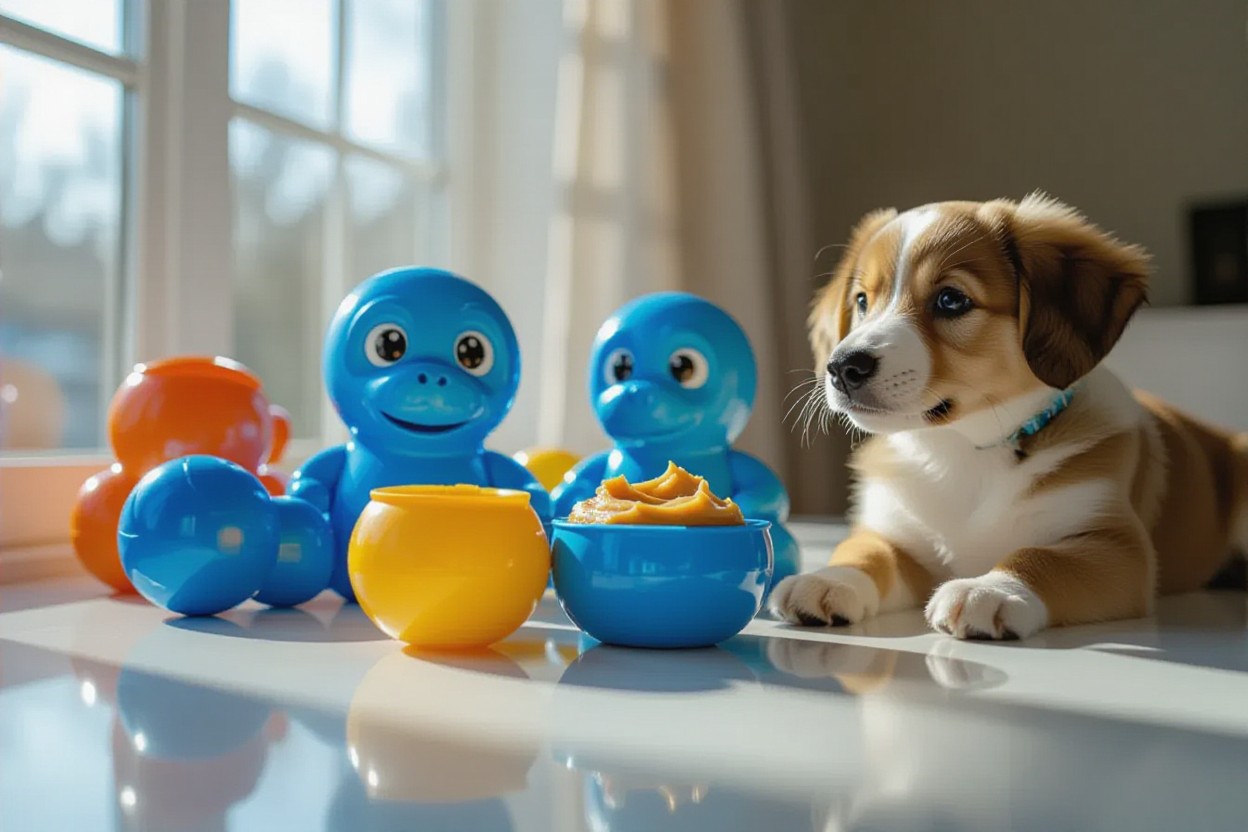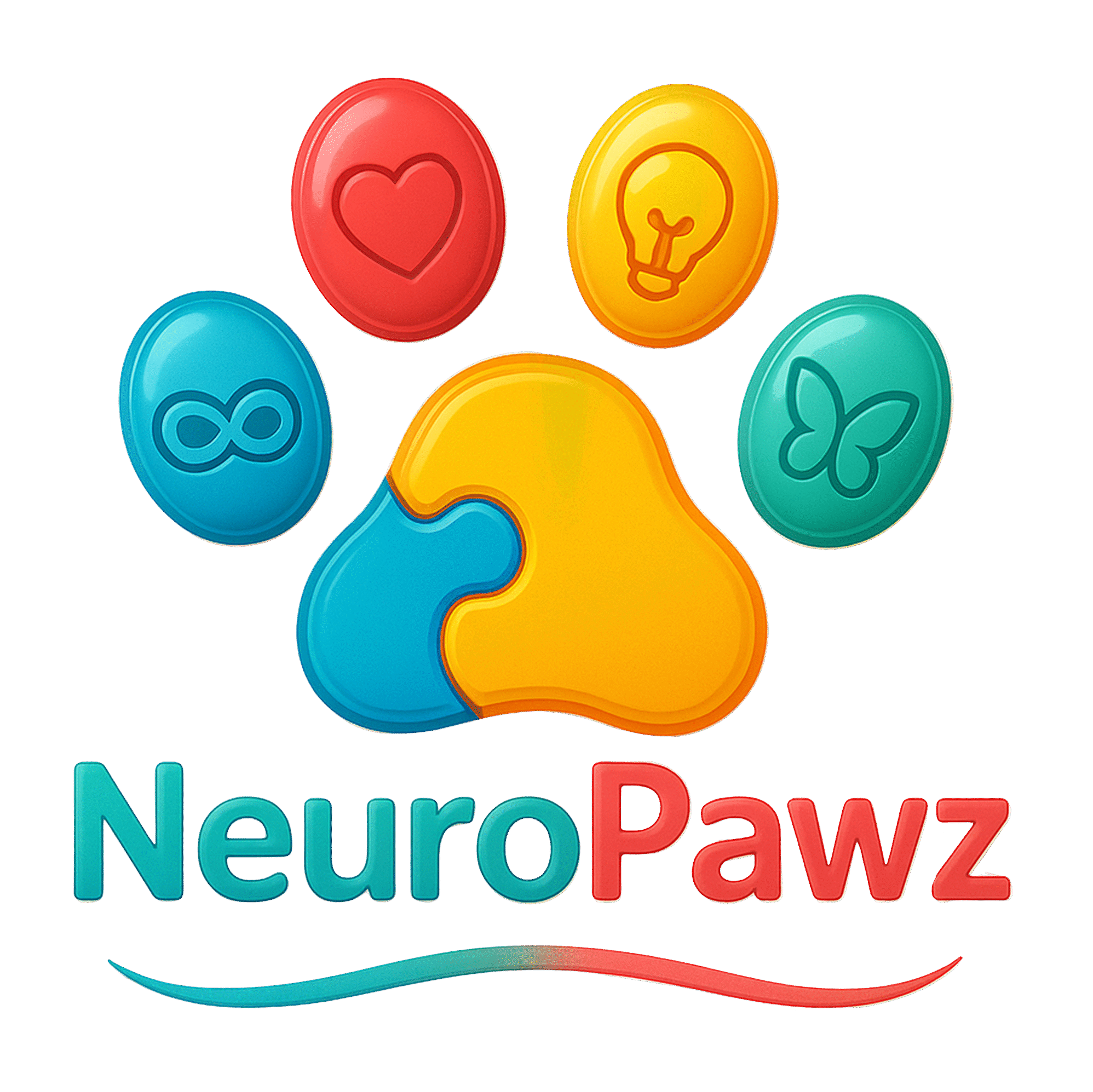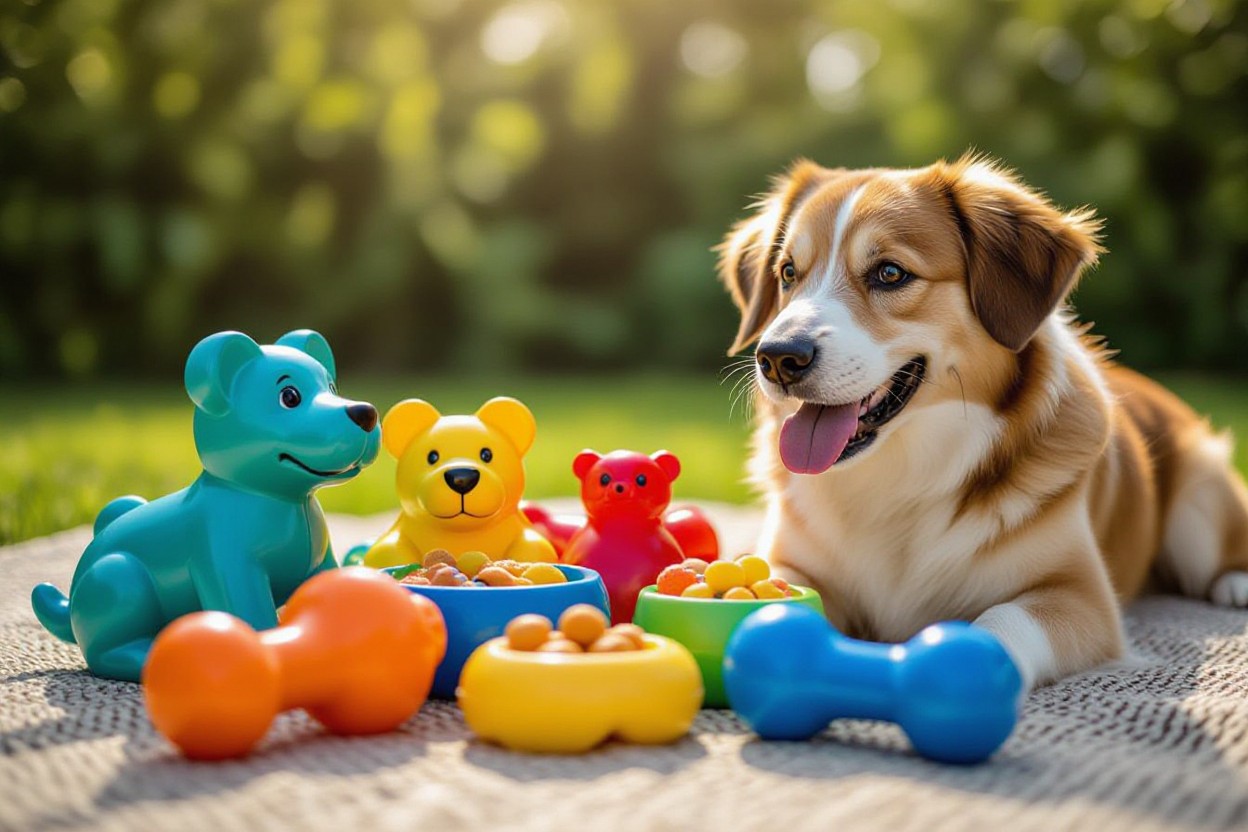There’s a reason KONG Toys are a staple for pet owners: they offer durable, high-quality construction that lets you use them for play, enrichment, and training to provide mental stimulation and reduce destructive behavior in your dog. You can stuff them with treats, use them for fetch, and integrate them into training routines, but be aware that chewed or damaged pieces can pose a choking hazard, so always choose the right size and replace worn toys to keep your pet safe.
Key Takeaways:
- Durable, chew-resistant designs and varied textures provide lasting mental and physical stimulation, reducing boredom-driven behaviors.
- Function as treat-dispensers and training aids to reinforce commands, encourage problem-solving, and slow eating for digestive health.
- Offered in sizes and materials for different breeds and ages, supporting safe solo play, interactive enrichment, and anxiety relief when matched appropriately.
Understanding KONG Toys
History and Development
You should note that KONG began in 1976 when Joe Markham molded a bouncy, hollow rubber toy inspired by automotive rubber; it evolved over 40+ years into models tested for durability and safety. You’ll see iterative updates — softer compounds for puppies, firmer blends for power chewers — and industry testing standards that guide sizing and replacement intervals to limit hazards.
- KONG Classic — original, stuffable, multi-use.
- KONG Puppy — softer compound for teething dogs.
- KONG Extreme — designed for heavy chewers and power jaws.
- Materials — natural rubber compounds with tested resilience.
- Thou choose the correct size and inspect regularly for shredded pieces.
| Model | Best for / Key features |
| KONG Classic | All-purpose, hollow center for treats, sizes XS–XXL, great for enrichment. |
| KONG Puppy | Softer rubber for puppies under ~12 months, gentler on new teeth. |
| KONG Extreme | Firmest compound for powerful chewers; recommended for aggressive chewers only. |
| KONG Senior | Softer than Classic, reduced bounce, aids older dogs with joint or dental sensitivity. |
| KONG Wubba / Plush | Interactive fetch/tug toys with fabric tails; not for unsupervised heavy chewing. |
Different Types of KONG Toys
You’ll find several categories: hollow rubber toys for stuffing, treat-dispensers that encourage problem-solving, softer puppy compounds, heavy-duty chew models for strong jaws, and plush or interactive options for retrieval. You can match sizes XS–XXL to weight and jaw strength, and many shapes alter bounce and unpredictability to stimulate your dog’s instincts while training or preventing boredom.
- Rubber hollow — fillable for mental enrichment.
- Treat-dispensing — slows feeding, rewards problem solving.
- Puppy — teething-friendly texture and gentler bounce.
- Heavy-duty — for dogs that destroy ordinary toys quickly.
- Thou confirm the toy’s intended use before unsupervised play.
| Type | When to use |
| Hollow Rubber (Classic) | Stuff with soft fillings; good for separation anxiety and slow feeding. |
| Treat-Dispensing | Use for training sessions or to extend mealtime engagement. |
| Puppy Compound | Offer to teething puppies under ~12 months to soothe gums. |
| Extreme / Heavy Chew | Reserve for dogs that routinely destroy standard toys; monitor wear. |
| Plush / Interactive | Best for supervised fetch and tug; not suitable for sustained chewing. |
You can increase engagement by varying fillings and techniques: small KONG Classics hold roughly 1–2 tablespoons of dense paste, or 10–30 kibble pieces depending on size; freezing a peanut-butter-and-yogurt mix can extend play from minutes to hours. You’ll pair size and compound to match weight and chewing style, rotate toys weekly to maintain novelty, and discard any toy with more than minor surface damage to avoid ingestion of fragments.
- Stuffing ideas — peanut butter, plain yogurt, kibble mixtures.
- Freezing — prolongs engagement and increases reward duration.
- Rotation — swap toys every 3–7 days to sustain interest.
- Inspection — check for tears; remove if pieces detach.
- Thou prioritize safety by matching toy type to your dog’s chewing intensity.
| Filling | Effect / Tip |
| Kibble | Good for slow-feeding; 10–30 pieces fits depending on KONG size. |
| Peanut butter (xylitol-free) | High-value reward; use 1–2 tbsp and freeze for longer play. |
| Yogurt or pumpkin | Lower-fat options; combine with kibble for texture variety. |
| Wet food | Strong scent boosts interest—serve in moderation to control calories. |
| Layered mixes | Alternate soft and hard layers to increase problem-solving time. |
The Importance of Pet Enrichment
Enrichment directly reduces boredom-driven damage like chewing, digging and excessive vocalizing by giving your pet purposeful outlets for natural behaviors. You can use KONG puzzle fillers, scent trails, or timed treat-dispensing games to simulate foraging and keep engagement from a few minutes to over an hour depending on the challenge. In shelters and homes, consistent enrichment correlates with calmer dogs and faster adoptions; mental engagement lowers problem behaviors and improves welfare.
Psychological Benefits
You’ll see reduced anxiety, fewer compulsive actions, and improved focus when you supply daily cognitive challenges; interactive KONGs and clicker-based training turn rewards into learning. Cats benefit from short, intense stalking play and food puzzles that satisfy hunting drives. Research links enrichment to lower stress indicators (behavioral signs and hormonal markers), so even 10–20 minutes of targeted play several times a day can produce measurable improvement in mood and behavior.
Physical Health and Activity
You improve fitness and weight control by pairing enrichment with movement: vets often recommend roughly 30–120 minutes of activity per day depending on breed, age and condition. Activities like KONG-based fetch, treadmill sessions, and scent hikes build muscle and burn calories; given that over 50% of pets are overweight, structured play helps reduce obesity-related joint and metabolic risks.
Match intensity to your pet: a Border Collie may need 60–120 minutes of mixed high-intensity fetch and problem-solving, while a small companion dog often thrives on 30–45 minutes split into multiple sessions. For cats, aim for 5–15 minute play bouts 2–4 times daily with varied toys (prey-style wands, food puzzles, climbing structures). Rotate toys weekly to prevent habituation and alternate high-exertion play with scent or puzzle-focused recovery sessions. Use appropriately sized, intact toys and supervise chewers to avoid ingestion of fragments; replace damaged items promptly. Track activity in a simple log or with a pet activity monitor to adjust duration and intensity, and combine enrichment with portion-controlled feeding to protect weight and joint health.
Playtime with KONG Toys
Stuffing a KONG Classic with kibble and a smear of peanut butter can keep your dog busy for 10–30 minutes, and freezing that same fill often extends engagement to 1–3 hours. Choose a Soft KONG for puppies, Classic for average chewers, and Extreme for powerful jaws; inspect and replace any toy that shows splits or missing chunks to avoid ingestion. You’ll find that simple adjustments to stuffing density and temperature let you control challenge and duration precisely.
Interactive Play
Rotate 10–15 minute interactive sessions 2–3 times daily to build focus and bonding, using the KONG as a reward during sit, stay, or fetch drills. Try a game where you toss a KONG Wobbler to release kibble when your dog noses it, then reward calm behavior before re-engaging. Trainers commonly pair KONGs with impulse-control exercises; you’ll see faster gains when you time rewards and increase difficulty gradually.
Solo Play and Engagement
For independent enrichment, use layered fills—kibble, small treats, then a sticky topper—to create a progressive challenge that lasts 5–90 minutes depending on size and stuffing. Puzzle-style KONGs and the Wobbler are ideal for solo use; however, frequent inspection is imperative because vigorous chewers can damage toys and create a safety hazard. Rotate toys to maintain novelty and engagement.
Start by packing dry kibble, add a dense paste (canned pumpkin or plain yogurt), then freeze for 2–4 hours to turn a simple KONG into a long-lasting crate-time solution; many owners report 30–90 minutes of calm. Clean regularly—most KONGs are dishwasher-safe—and adjust fills for calorie budgets so your dog’s diet stays balanced while enjoying independent play.

KONG Toys for Training
You can integrate KONG toys into structured training by pairing them with cues, using the KONG Classic or Wobbler for food-driven tasks, and choosing KONG Extreme for powerful chewers. Start with short, focused sessions (5–10 minutes) and progress to longer foraging challenges; stuffing with kibble, yogurt, or peanut butter and freezing for 1–2 hours increases engagement. Trainers often use KONGs to teach impulse control, loose-leash focus, and independent settling while monitoring toy condition and appropriate size.
Positive Reinforcement Techniques
Pair the KONG reward with a clear marker (clicker or “Yes!”) and immediate release of the toy after the desired behavior; you can use a variable reward schedule—treats every time, then switch to intermittent—to build persistence. Start by placing high-value food on the surface, then bury it deeper over 3–5 sessions to add difficulty. Many trainers recommend 3–7 minute KONG puzzles during crate training for calm settling and to reinforce sit-stay or recall by offering the toy as the reward.
Addressing Behavioral Issues
For separation anxiety and destructive chewing, give a stuffed-and-frozen KONG 10–60 minutes before departures to encourage calm independent play; combine this with short, low-key exits that gradually increase by 5-minute increments. Use size-appropriate KONGs and inspect for wear daily—chewed or small pieces pose a choking hazard. If resource guarding appears, trade the KONG for high-value treats during supervised sessions and consult a behavior professional for escalation.
To implement a stepwise plan, begin with 5-minute absences over a week, pairing each departure with a well-stuffed KONG (kibble mixed with plain yogurt or canned pumpkin, frozen 1–2 hours). Increase absence time by 5–15 minutes every 2–3 days while monitoring stress signals (pacing, excessive drooling). For intense chewers, switch to KONG Extreme and rotate toys to maintain novelty; if you see frayed edges or missing chunks, replace immediately. Combine KONG-based enrichment with obedience drills and counterconditioning for lasting behavior change.
Choosing the Right KONG Toy for Your Pet
You should match KONG style and size to your pet’s mouth, chewing intensity, and activity: use the Puppy KONG (softer rubber) for teething, the Classic for average chewers, and the KONG Extreme (black) for aggressive chewers. Consider whether you need a bounce toy, a stuffable toy for enrichment, or a treat-dispensing model for training, and always inspect for wear—if a toy is ripped you must replace it to avoid a choking hazard.
Size and Durability Considerations
Select from XS through XL based on jaw size and bite force: small breeds need XS–S soft or classic rubbers, medium breeds M, larger breeds L–XL and often the Extreme formula. You should match durability to behavior—gnawers that shred toys need Extreme rubber—while chewers that gnaw intermittently do fine with Classic. Inspect weekly and retire toys with deep cuts or missing chunks to prevent ingestion risks.
Customizing for Different Breeds and Temperaments
You can tailor fill, firmness, and playstyle: scent-driven hounds (Beagles) love dense, food-filled KONGs; retrievers benefit from buoyant, bouncy KONGs for fetch; anxious dogs respond well to long-lasting frozen fillings. For sustained engagement, freeze a stuffed KONG for 2–4 hours to extend play by roughly 30–90 minutes, depending on filling density and ambient temperature.
Practical customization: pack kibble mixed with pumpkin puree, plain yogurt, or xylitol-free peanut butter, seal the hole with a bit of kibble then freeze. Use KONG Easy Treat pastes for quick stuffing or layer softer foods inside firmer ones for graduated difficulty. Supervise initial use, rotate toys weekly to maintain novelty, and avoid fillings with xylitol or small hard objects that could break free and pose a swallowing risk.
Tips for Maximizing KONG Toy Benefits
Rotate KONGs, match the model to your dog’s chewing style, and schedule short, supervised sessions to keep novelty high; inspect toys regularly and remove if torn to prevent ingestion. Use KONGs for training rewards and slow feeding to reduce gulping. Recognizing patterns of overuse versus enrichment lets you adjust frequency, filling complexity, and supervision to keep your dog engaged and safe.
- Durability
- Enrichment
- Training
- Dental health
- Supervision
Filling and Treating Your KONG
Fill to about 50–75% with high-value mixes—unsweetened peanut butter (no xylitol), plain yogurt, canned pumpkin, or soaked kibble—seal with a thin layer and freeze for 1+ hour to extend challenge time; warm briefly and test temperature for cozy treats. Clean by rinsing and using the dishwasher or a stiff brush, and always supervise initial uses to check fit and tolerance.
Creative Play Ideas
Hide KONGs for scent games, toss tougher KONGs for controlled fetch, or use them in crate sessions as positive reinforcement; attach to a wobble base for rolling puzzles and rotate toys every 2–3 days to sustain interest. Supervise heavy chewers and tailor games to your space and your dog’s skill level.
Begin hide-and-seek by showing the KONG, then hide it progressively under towels, behind furniture, and inside low boxes; for training, require a sit or nose touch before offering the KONG and increase the delay from 5 to 60 seconds to build impulse control. Combine a scent trail of kibble leading to a frozen, stuffed KONG to extend play, give each dog its own labeled KONG in multi-dog homes to avoid guarding, and rotate textures and fillings weekly to maintain novelty while you supervise interactions.
FAQ
Q: What benefits do KONG toys offer for pets beyond basic play?
A: KONG toys provide mental stimulation by encouraging problem-solving and sustained engagement, which reduces boredom-related behaviors (chewing, digging, barking). They offer physical exercise when used for fetch or interactive games. Fillable KONGs slow feeding and help prevent gulping; they can also reinforce training by delivering predictable rewards. For anxious pets, a properly introduced KONG can offer comfort and distraction during alone time. The variety of sizes and rubber formulations supports different life stages and chewing styles, making KONGs adaptable for enrichment, exercise, and behavior management.
Q: How do I choose the right KONG model and size for my pet?
A: Match size to your pet’s mouth—too small is a choking risk; too large is hard to handle. Choose rubber firmness by chewing strength: puppy (soft), classic/standard (medium chewers), or extreme (powerful chewers). Consider the model: classic/fillable for enrichment and slow-feeding, ball or Flyer for fetch, Wubba for interactive tug, and senior/softer formulas for older pets or dental sensitivity. For multi-pet households, use different sizes or colors to prevent resource guarding. Replace any KONG that shows significant tearing or sharp edges.
Q: How can I use KONGs for training, enrichment, and separation support, and how should I clean them?
A: Training: use stuffed KONGs as high-value rewards during sessions—short sessions with quick retrieval, then give a stuffed KONG for longer independent engagement. Enrichment: vary difficulty—loose kibble for quick play, mix wet food with kibble or mashed vegetables for moderate challenge, freeze for long-lasting occupation (freeze in stages to layer treats). Separation support: give a stuffed/frozen KONG immediately before departures to create a positive association and extend focus away from the owner; start with short absences and increase time gradually. Safety/cleaning: supervise initial uses, avoid toxic fillings (e.g., anything containing xylitol, chocolate, grapes, or raisins). Wash after use with warm, soapy water; many KONG products are top-rack dishwasher-safe—check packaging. Discard or replace when the toy is damaged or develops jagged edges.
“Guess what? When you click and buy through our links, you’re helping us keep the NeuroPawz community thriving. It doesn’t cost you a whisker more 🐱, but it means we can keep fetching the best calming beds, cozy toys, and comfort tips for you + your pets. Win-win!”

